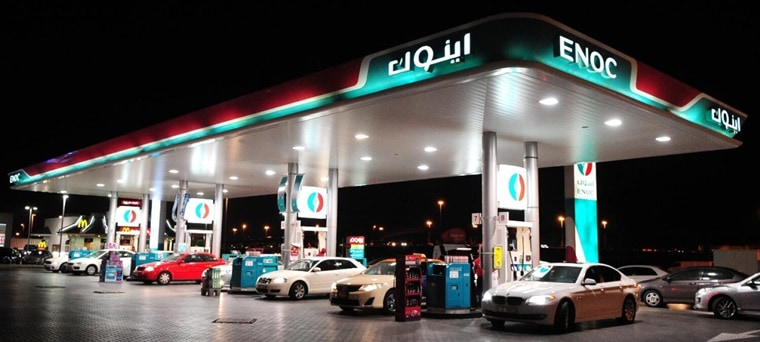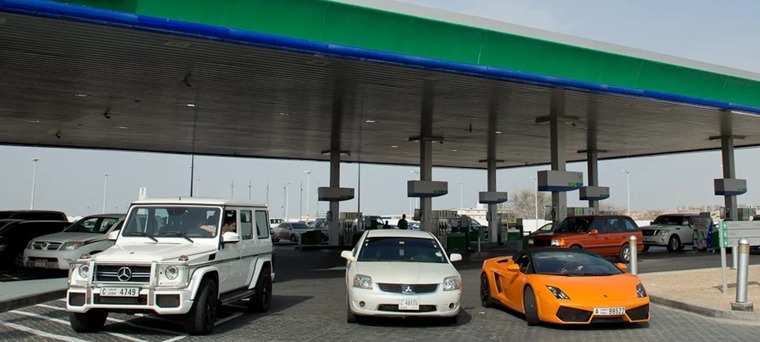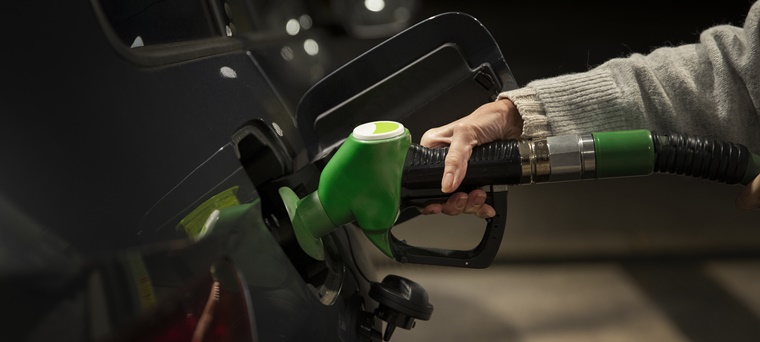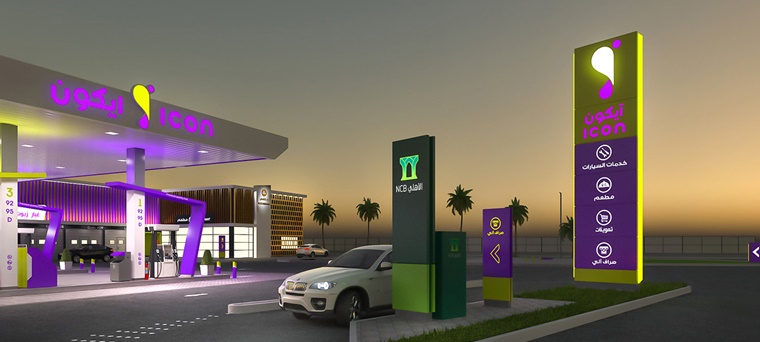

30.07.2025
1086
What's this about? Petrol in Dubai costs approximately the same as in Russia. Prices have significantly increased over the past 10 years, which is clearly visible in the dynamics. The cost of petrol is reviewed monthly by the Fuel Committee.
What to consider? Petrol prices don't always just increase. Sometimes, fuel becomes cheaper by several fils and stays at this level for a couple of months. Petrol stations offer discounts to regular customers, which significantly helps to save on car budget in the UAE.
Petrol prices in the UAE are an important global economic factor. Until 2015, the Emirates were a true paradise for motorists due to cheap fuel. However, global changes in the oil market forced adjustments, causing an increase in petrol prices in the country. The situation changed dramatically when the UAE government decided to deregulate fuel prices.

A special Fuel Committee was established under the Ministry of Energy. It was headed by Matar Al Neyadi — Deputy Minister. The body is located in Dubai. Its staff includes representatives of the country's leading fuel companies. Since 2016, it has been responsible for monitoring the global market prices for oil, petrol, and diesel fuel. The committee sets new fuel prices every 30 days, based on analysis of global dynamics. Therefore, monthly changes in petrol prices are observed in Dubai, Abu Dhabi, and Sharjah. The reasons for these fluctuations lie not only in the will of the Fuel Committee and UAE government but also in careful analysis of global oil price dynamics.
This causes commotion at petrol stations, especially when price drops are announced in Dubai. Drivers rush to fill up their tanks, and then possibly return to queue again to refuel at the reduced price. The head of the Fuel Committee gives the following commentary on price fluctuations:
The moment of petrol price jump and parallel drop in diesel fuel prices in the UAE became a turning point for the country.
Firstly, this measure helped strengthen the state's economic system. Reducing subsidies frees up significant budgetary resources that can be directed to socially significant projects and infrastructure development. Secondly, environmental benefits are obvious. This includes reduction of greenhouse gas emissions and improvement of air quality due to the transition to more economical and environmentally friendly vehicles.
Thirdly, careful management of natural resources. Increasing fuel prices stimulates the development of alternative energy sources and helps reduce dependence on fossil fuels. Fourthly, this situation is a serious signal for country residents that monthly fuel costs can be significantly reduced with a rational approach to its consumption. This is especially important for people with low incomes, for whom petrol costs constitute a significant part of the family budget.
At the beginning of 2025, petrol prices in the UAE increased by 25%, as shown below.
Table 1. Petrol prices in the UAE.
| Petrol Type | Price per litre | ||
|---|---|---|---|
| in dirhams | in roubles | in Moscow | |
|
Special (95) |
2 dirhams 14 fils |
36 RUB |
37.6 RUB |
|
Super (98) |
2 dirhams 25 fils |
37.6 RUB |
42 RUB |
|
E Plus (cheapest) |
2 dirhams 7 fils |
34.64 RUB |
33.6 RUB |
However, this is not the first case of such sharp changes. In 2015, despite the increase in fuel prices, diesel fuel rates dropped by 29%, reaching 2 dirhams 5 fils per litre or 34.3 roubles. In October 2016, petrol prices in Dubai nearly doubled. At that time, companies strongly recommended switching to the cheaper and more environmentally friendly E Plus 91, which cost 5.75 dirhams per litre.

In July 2023, petrol was more expensive. Prices are shown in Table 2.
Table 2.
| Petrol Type | Price per litre | ||
|---|---|---|---|
|
in dirhams |
in US dollars |
||
|
Special (95) |
2.45 |
0.66 |
|
|
Super (98) |
2.56 |
0.69 |
|
|
E Plus 91 (cheapest) |
2.37 |
0.64 |
|
|
Diesel |
2.66 |
0.72 |
|
In July 2023, Adnoc Distribution petrol stations introduced a fee of 10 dirhams or 2.7 US dollars for premium service — fuel filling by staff.
Table 3. Petrol prices in the UAE from late January to early April 2025.
|
Period |
Price in dirhams |
|---|---|
|
January 21 |
1.89 |
|
January 28 |
1.89 |
|
February 4 |
1.84 |
|
February 11 |
1.84 |
|
February 18 |
1.84 |
|
February 25 |
1.84 |
|
March 4 |
1.92 |
|
March 11 |
1.92 |
|
March 18 |
1.92 |
|
March 25 |
1.92 |
|
April 1 |
2.11 |
At the beginning of 2025, the average petrol price in different emirates varied from 1.84 to 2.11 dirhams, while in other countries worldwide it was 5.53 dirhams.
It differs significantly from global trends, radically standing out against the background of the global oil market. The reasons that allow enjoying this economic well-being lie in the unique system of subsidies and tax benefits. It is also influenced by the powerful oil production industry.
Foreigners arriving in the UAE for work often choose to purchase their own car instead of using public transport. This is easily explained: buying a car here is not something unaffordable, especially when an international driving licence opens up freedom of movement across such developed road infrastructure.

Dubai, known for its role in the global oil economy, receives a stable income from black gold exports. And although the Emirates' economy is gradually diversifying, it remains the most important source of income. In 2023, there were notable changes in petrol prices: at the beginning of the year, there was a 5% increase, however, in summer, against the background of global economic conditions, they were adjusted 2% downward.
Furthermore, in the first months of 2023, the government introduced a value-added tax of 5%. In July, the price dropped by 2%, but a service fee for filling petrol was introduced. This charge can be avoided by using a self-service pump. Exceptions are made for persons with disabilities and elderly citizens, for whom benefits are provided.
In 2025, the cost of a litre of petrol in Dubai is 36 roubles. This is 1.75 dirhams, which converts to 54 cents in US dollars. For comparison, the average price of a litre of petrol in Russia is 44 roubles. Although the difference in fuel costs between the UAE and Russia is small, the standard of living in Dubai significantly exceeds that of Russia. This makes the cost of petrol even more advantageous for local residents and expats.
Most petrol stations in Dubai are arranged like small oases, where you can find not only fuel pumps but also car washes, service stations and shops. There are often cafes and even mosques, which makes stopping at a petrol station much more convenient and pleasant.
Pump attendants always have portable terminals, so you can easily pay by card right on the spot.

In some cases, it's more convenient to pay in cash to avoid temporary blocking of funds. This is especially relevant for those who don't want to wait for the return of remaining funds. The thing is that when paying for petrol by card in Dubai, an amount of around 80 dirhams (approximately $21.78) is frozen, even if you're filling up for a smaller amount. The remaining money isn't returned immediately. It usually takes 1–2 days.
Some petrol stations charge an additional fee of 10 dirhams (approximately $2.72) for attendant services. For this amount, they will clean your windscreen, check tyre pressure and offer small discounts at 24-hour station shops. However, the additional charge is not applied at all stations, only at those where pumps are marked as 'Premium'. For example, in the ADNOC network, attendant services have been free since November 2019.
Interesting fact: people with disabilities and retirees are exempt from paying 10 dirhams even for premium service.
This system exists in the Emirates, but self-service isn't popular there. Local petrol stations tried to attract customers by lowering prices, however, in hot and humid climate conditions, few are willing to leave their air-conditioned cars for minimal savings. Self-service stations are located along Sheikh Zayed Road and operate only at night, from 0:00 to 6:00, when the air temperature drops. All pump instructions are duplicated in English.
To effectively manage fuel expenses, consider the following strategies:
Until recently, fuel costs were so low that many preferred to use their cars everywhere. Office workers even ordered car refuelling at their workplace to avoid queuing at petrol stations. This was due to the fuel crisis caused by falling oil prices in the global market.

The situation changed in the second half of 2015 when fuel prices began to steadily rise. This led to car rental in the UAE becoming less attractive for tourists and locals. Until quite recently, the idea of renting a car in the United Arab Emirates seemed undisputable: convenient for sightseeing and travelling across different regions. However, now that fuel costs in Dubai are rapidly rising, car rental in the UAE is losing its former appeal and becoming less economical.
The range at Dubai petrol stations will satisfy any needs. For example: Regular (91 octane petrol) is a basic option; Special (95 octane) — improved; Super or Premium (98 octane) — high-quality petrol; economical diesel. Each has its own advantages.
In the UAE, VAT of 5% is added to the petrol price.
Fuel prices in Dubai and across the UAE constantly change under the influence of global and domestic economic factors, making expense management a challenging task. To preserve the budget and reduce costs, it's necessary not only to track the latest market changes but also to apply innovative ways of fuel saving. Smart drivers actively optimise their routes, use advanced technologies for cost monitoring and develop eco-friendly driving habits. This helps not only to reduce expenses but also to preserve the environment.